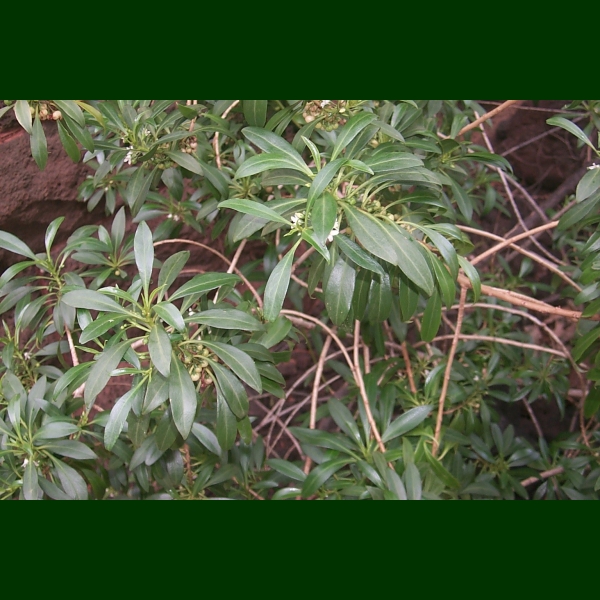 Hawaiian Name(s): naio, naeo, naieo
Hawaiian Name(s): naio, naeo, naieoScientific Name: Myoporum sandwicense
Vernacular Name: false sandalwood, bastard sandalwood
Family: Scrophulariaceae
Status: indigenous
Authority: A.Gray
Description: Shrub/small tree 1-15 m tall.
Habitat M. sandwicensis occurs a number of different habitats from strand vegetation, to dry forest, lava flows, mesic to wet forest, & in subalpine forest 0-2380 m (Wagner et al. 1990:928–929).
Medicines: To treat nae kulou and waiopua paa, or stubborn case of asthma, ‘ākia manalo leaves (Wikstroemia spp.), naio leaf buds and leaves, the bark of ohi‘a ai (Syzygium malaccense) and hi‘aloa (‘uhaloa, Waltheria indica) tap roots, dried niu (coconut, Cocos nucifera), and kō aina kea (sugarcane, Saccharum officinarum) are pounded into a mash and the mixture is strained with ahu‘awa (Cyperus javanicus). The liquid is drunk cold for five days, twice a day. (Chun 1994:23-25). For the illness ma‘i hemo keiki o na wahine hanau nui I ke keiki (child birth of women who have had many children) hala aerial roots (Pandanus tectorius), niu, kohekohe (Eleocharis spp.), hala leaf buds, ala‘alawainui pehu stems (Peperomia spp.), ‘ihi makole (Oxalis spp.) and naio leaf buds, fruit and leaves, kukui flowers (Aleurites moluccana), noni fruits (Morinda citrifolia), and kō kea (white sugarcane, Saccharum officinarum) are pounded into a mash and strained with ‘ahu‘awa. The liquid mixture is heated. Once cool, the medicine is taken two times a day, once in the morning and again in the evening (Chun 1994: 73-74).
Non Medicinal Uses: Wood has odor similar to sandalwood (Degener 1930:267). Used for house posts (Degener 1930:268; Krauss 1993:56). Burns well and long, used for torches (Lamb 1981:127). Wood used for fish net gauge (haha ka ‘upena) (Krauss 1993:35). In the Ethnology Collection at Bishop Museum there is a post-contact example of the wood made into a bowl.
Specific gravity of wood: 0.55
Famous Locations:
Mele:
`Ōlelo Noeau:
Dye Color and Parts: Pink, white (flowers)
Kino lau:
Location on Bishop Museum Kalihi Campus: courtyard
Propagation Information: Easy. Presoaked seeds buried 1 cm below moist vermiculite, germinates in 2 weeks with bright light, water/mist regularly, transfer to individual pots when leaves appear & fertilize lightly; rapid growth, pruning should only be done in vigorous state of growth, also grows from cuttings (Bornhorst 1996:42–43; Bornhorst and Rauch 1994:11–12; Culliney and Koebele 1999:114–117; Nagata 1992).
Hawaiian Native Plant Propagation Database.
Native Plants Hawaii.
Microscopy
Cross Section: Field of view: 2.6 mm x 1.6 mm. Photograph: H.Lennstrom

Radial Section: Field of view: 2.6 mm x 1.6 mm. Photograph: H.Lennstrom

Tangential Section: Field of view: 2.6 mm x 1.6 mm. Photograph: H.Lennstrom

